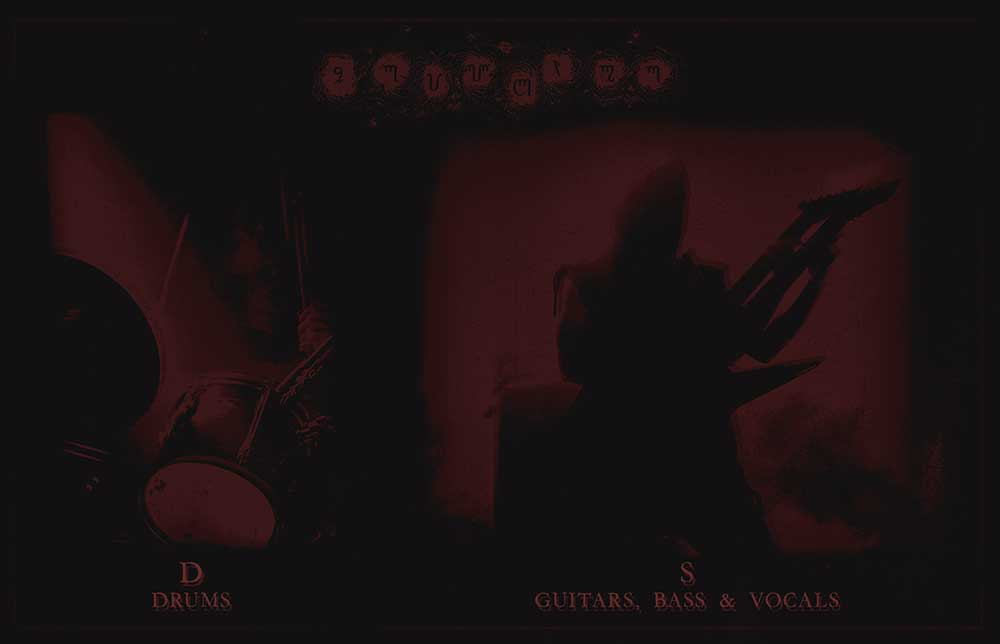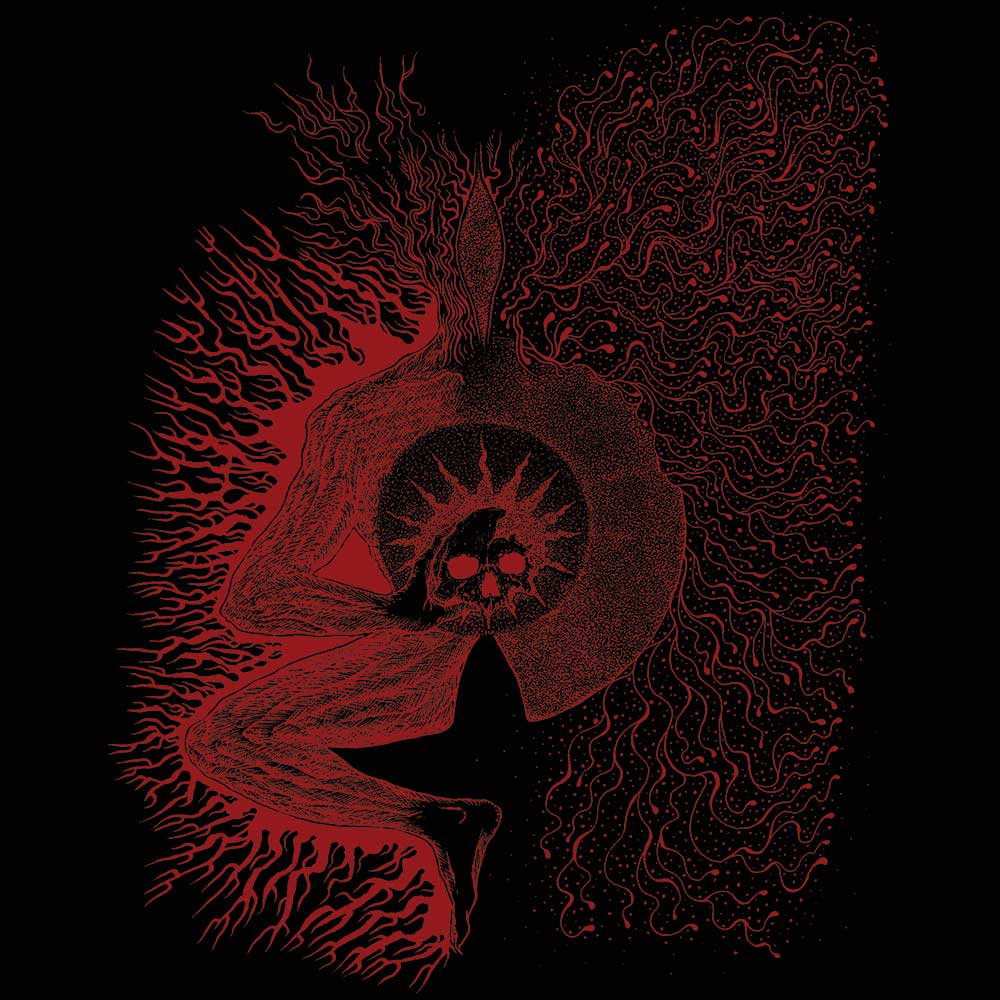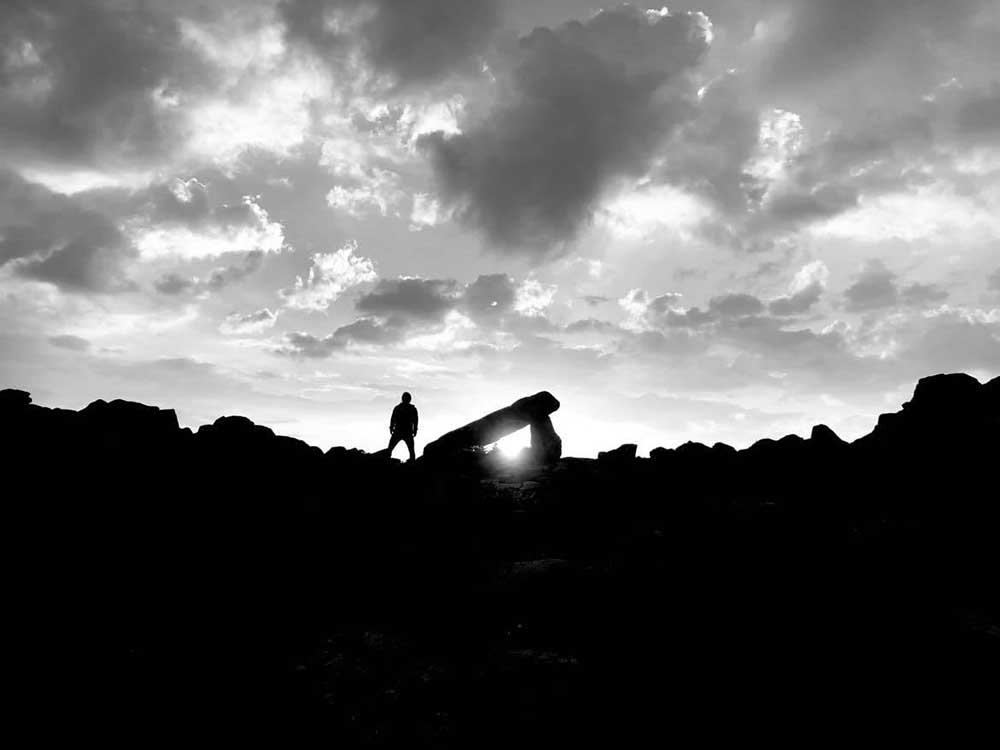Qrixkuor
2022-11-30
by Niklas Göransson
From the terror of the cyclic infinite – Qrixkuor return with Zoetrope, an EP that pushes the musical boundaries of death metal. Includes an exclusive full album stream.
– There is one rather obvious matter to address before we can proceed. It would not be like either of us to shirk it, though I’d prefer to quickly turn the focus to how we got out of the hole this debacle left us in rather than have this interview descend into the world of shit of the weeks following that February article. Not exactly something that typically comes up in any kind of media-training seminar.
S is no stranger to sudden and dramatic line-up developments. In the immediate aftermath of QRIXKUOR’s 2016 “Three Devils Dance” EP, the entire band dissolved – leaving S alone with his vision of the much-anticipated debut album. Leading up to the new EP, he instead had a bandmate confessing to the possession and distribution of child pornography.
– The response to what’s alleged should be obvious and has been well-documented; I don’t have much further of substance to add. Nor do I feel compelled to rant about something that I honestly just feel fucking sad about on multiple levels. Any attempt at a public explanation – if there can be such a thing – should come from the man himself. In the absence of this, we move forward. I truly hope that we can leave this in 2022 and am glad that we’re able to close out the year by finally presenting this EP, which deserves to be absorbed without prejudice.
The masters for “Zoetrope”, which is due for release by Invictus Productions on December 2, were originally signed off on February 18. Six days later, QRIXKUOR’s session bassist – New Zealand native Phil Kusabs of VASSAFOR – became the centrepiece of an article titled Death metal musician admits sharing child sex abuse material.
– At that time, I had just as little idea about the imminent storm brewing as anyone else. Once the news broke it became patently obvious that the release could not proceed with the personnel involved, and that we’d need to return to the studio and re-record his basslines. This in itself proved to be somewhat of a challenge, having already crossed the line of mentally considering the EP complete.
On “Poison Palinopsia”, QRIXKUOR’s 2021 debut album, the bass guitar played a crucial role in the soundscape. This approach was carried over to “Zoetrope”. Consequently, S was now faced with the unenviable task of – at zero notice – substituting someone considered by many as being among the best bass players in extreme metal.
– Our last conversation covered my motivations for the choice of participants on “Poison Palinopsia.” I also told you that if Phil wasn’t going to play the bass, then I’d have done it myself. So, when that eventuality came to pass, I set about not only replacing his parts but, in the true spirit of never surrendering, also attempting to decimate them in terms of quality: the only way that I’d be able to live with the recording going forward. The focus required for this endeavour, the hunger to achieve it, and what I believe to be its successful fruition became a sizeable factor in the process of moving on from the situation, both personally and for the band. I relish a challenge and might even have enjoyed it under different circumstances but – for obvious reasons – this one took me a long time to connect with mentally.
After several weeks’ worth of toiling at Greg Chandler‘s Priory Studios, S had turned in a bass performance he was content with. By mid-April, the new mastering was finished.
– We originally began recording on January 3, so it was something of an ordeal to spend several months living inside an unfinished creation this complex and intense. Nonetheless, I am immensely satisfied with the result: it reinforces “Zoetrope” as QRIXKUOR’s greatest victory thus far. It is my own bass interpretation from scratch and quite different from the original. Actually, seeing as how I worked on the basslines so obsessively, and more recently than the other elements, that’s what I immediately tune into when listening back to the EP now – which has never happened before. Surpassing this on the next recording will be quite the task.

Besides the last-minute bass replacement, QRIXKUOR also has a new drummer. On “Poison Palinopsia”, DBH of GRAVE MIASMA – whom S plays alongside in ADORIOR – lent his talents.
– Following the demise of the original QRIXKUOR line-up, efforts to establish a full and functioning group of musicians proved ultimately fruitless. As such, “Poison Palinopsia” became more of a recording project than a band effort. That is perfectly fine and precisely what was needed to get the record done – which by that point had become a personal necessity – but I missed the interaction of building and honing material in the rehearsal room, for which geography and free time can both be limiting factors. So, I summoned the fanatic multi-instrumentalist D before anyone else realised that a very capable drummer not already tied to multiple projects now lives on these Isles.
D is a New Zealand native who, by way of Germany and then Scotland, now resides in England.
– His enthusiasm and work ethic quickly took what was originally slated as a simple jam session to something sounding much like a QRIXKUOR arrangement. With my homemade demos as a primitive starting point, we were able to construct and refine the EP track far more organically than before. In addition, we could rehearse enough to record the rhythm sections live. Writing and tracking live are factors that I feel made for an organically coherent but also naturally unhinged result, similar to how “Three Devils Dance” was conceived and captured.
The title, “Zoetrope”, refers to a 19th-century invention: a kind of cylinder with a series of images carved into its inner surface. When spinning, it creates the optical illusion of a continuous motion – almost like a primitive cartoon animation.
– Lyrically, “Zoetrope” deals with the terror of the cyclic infinite. It relates to an entheogen-induced experience where a couple of hours became a purgatorius perpetuity of eternal return, from which there appeared to be no escape. The zoetrope device seemed a fitting metaphor to help explain such horrors, quite apart from being a nod to the short film by the same name – beautifully scored by LUSTMORD – that originally brought it to my thoughts. The reason why the initial motif returns at the end of the piece was to reinforce this musically.
Another means of efficiently driving home the point is the rather striking cover, courtesy of Argentinian artist Santiago Caruso.
– Santiago’s work reflects this more accurately than I ever could’ve imagined. I did have some interest in seeing how Daniel Corcuera – the artist responsible for our previous two covers – could once again put our sound and words into an image, but he was on a hiatus from painting full covers. So, I turned back to Santiago whose work I’ve been entranced by as far back as “Three Devils Dance”, making this somewhat of a coming full circle. As brilliant as Daniel’s pieces were for us, it’s never a bad idea to step out of your comfort zone. I could not be more pleased with the contrasting yet complimentary style of the artwork provided by Santiago.

S mentioned in a previous conversation that part of his rationale behind following up the debut album with another EP – thereby halving the running time – was to allow for twice as much focus on the content. I’m curious how this worked out.
– Even from the earliest stages, I felt that the track worked best as a standalone piece and could not imagine what else to add to it. The assumption was that it would also be slightly easier on my brain to compose, arrange, and record. However, I apparently decided things weren’t difficult enough and managed to make the process at least three or four times the effort of the album – and that was before I had to re-record the bass – by going apeshit with the symphonic textures.
The simplest way to describe QRIXKUOR’s development is that the ambitious orchestral interludes from “Poison Palinopsia” have now merged with the music. As he did last time, S assembled a DIY orchestra of classically trained players and provided them with the music’s notation.
– Arranging and conducting such a collective of musicians requires some degree of both practical and theoretical knowledge. Mine is not what it was in my university days but, fortunately, I still speak enough of the language to liaise with the players and get a result somewhat close to my imagination. It was a constant learning process, but a rewarding one. In many cases, it was obviously far from the norm for the musicians I hired to be performing these kinds of melodies. I then combined this with other instruments and techniques already utilised in the past, as well as further experimentation with the use of my own voice.
The outcome is something that I can’t recall hearing anything even remotely similar to.
– One of my stated aims was to decimate the general perception of metal paired with the structures and instrumentation associated with classical music. Now, I generally cringe as much as anyone when I see adjectives such as ‘symphonic’ paired with black or death metal – because it usually means lifeless MIDI-software instruments playing pretty harmonies over quantised blastbeats and sterile riffs in a verse-chorus format that could not be further removed from any kind of actual classical structure. It has no expression whatsoever, which is the fundamental factor separating real music from the almost indistinguishable imitations modern computers are capable of.
These days, anyone with a rudimentary knowledge of musical theory and access to one of the countless sample libraries available online can pretty much assemble their own digital orchestra. The samples are actual recordings of real instruments which can be played in whatever notes one desires and then lengthened, shortened, or otherwise manipulated.
– It’s important to distinguish this from classic keyboard-assisted music, which adorns many records in my collection. I have far less of a problem with this because it usually isn’t trying to come off as ‘real’; what I’d like to stand above are these watered-down caricatures that I suppose are intended to add depth but, in reality, make the music sound soft as baby shit. Metal should thrive on darkness and aggression, and the classical music that utilises this kind of instrumentation can certainly match it in both regards… so why does any marriage of their characteristics sound completely fucking harmless almost every single time? There have been instances to the contrary – for example, early CELTIC FROST has been referenced more than once by listeners of “Zoetrope” – but I wanted to hear this taken even further.

Does QRIXKUOR now perform ‘symphonic death metal’?
– No. Whilst it’s obviously going to be a focus of this record – and for good reason – I want to make clear that I don’t see “Zoetrope” as being ‘classical influenced’ or ‘symphonic’ death metal per se, or that this is even the most important factor. The fact that these instruments are commonly employed in classical music is irrelevant – DEAD CAN DANCE use all kinds of traditional instruments and I’ve rarely seen anyone add such adjectives to their genre description. I simply saw paths in which the standard instrumentation of a metal band can be augmented in ways I’ve never heard before. We’ve done this on both “Zoetrope” and its predecessors with other instruments such as singing bowls, various bells, and death whistles.
The death whistle is an Aztec instrument – often shaped like a cranium – that produces a harrowing human-like shriek. They are believed to have been used both for ritual and warfare.
– I’m not a classical nerd, so this isn’t about bringing Mozart to the metal scene or introducing any kind of sophistication to a genre that – at its most effective – is often wholly unsophisticated. I don’t see this experimentation as drawing from anything other than the same pool of inspiration as the early days of worshipping SADISTIC INTENT, NECROVORE, or THE CHASM; it’s an extension of my passion for death metal and my desire to see it taken to new extremes in terms of texture and timbre.
Timbre, or tone colour, is the unique quality of the sound generated by each individual instrument or voice.
– In my head, the screech of a violin or soprano vocal pushed to its upper pitch limit – or the bass reverberation of brass instruments brought to the depths of their limits – is simply one and the same with wailing guitars and crashing drums. This is death metal that pushes the limits of what’s been a standard band line-up of the genre for thirty-five years. But to me, it’s still death metal: a genre that should have no ceiling in terms of horror.

Despite now having taken on the role of conductor, vocalist, and bass player, S is primarily a guitarist.
– Thanks to the shorter running time of an EP, we were able to record extra layers of individual parts of riffs with strings dissonantly ringing together – making the mix more of a three-dimensional experience, for lack of a better term. I also like to double-track my guitar leads and pan them apart to capture the subtle differences between the two and create a more chaotic result. On “Poison Palinopsia” there simply wasn’t enough time to do this with every single solo, but we managed it on “Zoetrope”; at great cost to both my and Greg’s sanity.
Is this practice commonplace?
– I wasn’t sure how common it was but recently learned that Randy Rhoads (OZZY OSBOURNE, QUIET RIOT) used to record three tracks of his leads – so there is a precedent of someone being even more obsessive than myself. For some reason, this always seemed like an obvious approach to me – I just couldn’t find the sound I wanted until I began adding layers. Off the top of my head, I might’ve picked this up from listening to leads such as those in the second half of MANILLA ROAD’s “Dreams of Eschaton”, or perhaps IRON MAIDEN live recordings where two of the three guitarists simultaneously play one of the solos from the early days. For better or worse, the “Rock in Rio” version of “Fear of the Dark” was a game-changer for the ten-year-old me.
Is being unique a goal in itself?
– It is not a particularly concerted effort to sound unique per se, no. Uniqueness as a quality can be overrated. I’d be perfectly happy to hear more effective SADISTIC INTENT clones – they’d just damn well better be striving for the best track that SADISTIC INTENT never wrote. We seem to have acquired a strange juxtaposition of opinions over the years; I’ve seen and heard comments implying that we are simultaneously completely unique and also utterly derivative. Perhaps the latter still persists from our earlier days, when there were many bands popping up with comparable styles.
When QRIXKUOR first came to the public eye, the wave of ‘cavernous’ death metal – as originated by the likes of PORTAL – was in full swing.
– I wouldn’t dispute that we did fit into that somewhat simply by virtue of having many of the same inspirations in a very fertile period for the style. However, I was bemused to see this still spouted with regards to “Poison Palinopsia”, including some baffling comparisons to bands I either do not like or have never even listened to. Perhaps this subconsciously drives us to pursue with greater vigour qualities that set us apart? It could also come down to me having increasingly less reserve about introducing or developing elements that I find appealing, with none of the regard for general perception I held in my youth.
So where does QRIXKUOR go from here?
– I’m sure some will say that our path has drifted somewhat in the last ten years, but I don’t see it that way. This was always the path, and everything feels as if it’s being taken in a completely natural direction towards an ultimate conclusion – whenever that may arrive. There are musical ideas on “Zoetrope” as old as the band itself, ones I couldn’t grasp how to most effectively express back then. I mentioned in our last interview that I’d considered the possibility that we could potentially have tried to reach further with “Poison Palinopsia” than we were capable of executing. A year and a bit on, I am becoming increasingly convinced that the point at which the artist reaches far beyond himself is where the spark of true magic lies, and that there’s no such thing as ‘too far’ at all.



